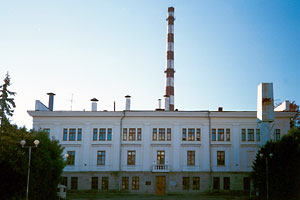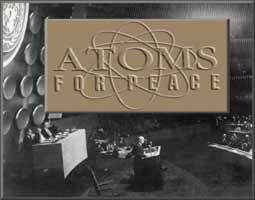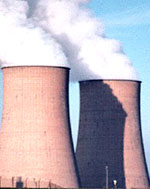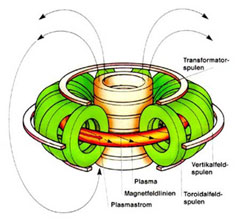 |
 |
Issue No.6 Autumn
|
| ENS News |
| Member Societies & Corporate Members |
New Nuclear Power
in Bulgaria |
| ENS World News |
European Nuclear Assembly
- ENA |
  |
| _____________________ |
|
| |
|||||||||||||||||||||||||||||||||||||||||||||||||||
|
It was to be followed by the MAGNOX reactors of Calder Hall, dual-purpose as well, inaugurated in 1946 by Queen Elizabeth II, by Shippingport, the first power PWR in 1957, then by G2 in Marcoule (1959) and, in 1962, both NPD, ancestor of the CANDU species, and the Windscale AGR prototype. It can be seen that, as early as 1962, a mere twenty tears after the Chicago experiment, all the present “species” were in |
existence, be it in embryonic form. Finally, in 1966 started the prototypes of what are still today would-be species: Dragon, the first HTR, built in Great Britain in the framework of an OECD Project, and the MSRE, molten Salt Reactor Experiment in the United States.
At the end of the 60s, the most advanced western state for the civilian use of nuclear power was Great Britain, the only one to have developed a true species. Several of those early MAGNOX are still in operation. Even more than the difficult development of the AGR species, it is the discovery and exploitation of the North Sea oil fields which have stymied UK’s nuclear development in the 70s and led to the loss of their leadership. As for the United States, in the 60s, their nuclear supremacy was mostly in Defense applications, including a monopoly on naval propulsion and uranium enrichment.
3. The Drivers of Selection.
From all the possible designs and the many promising prototypes, we know today that only a handful made it to industrial series, to become what we call here a species. This was not the result of any deliberate process, it was just “natural”, or spontaneous selection. The present operating reactors were, indeed, the fittest to survive; were they the fittest to generate safely and sustainably competitive electric power? This is an open issue…
The drivers of this selection have been various, some positive and some negative. Let’s start with the negative drivers which led to elimination:
Some branches aborted because of technological difficulties (like the lack of compatibility between sodium and graphite in the Hallam reactor), because the project was really overambitious (like the “air breathing” reactor for airplane propulsion), for being too cumbersome (like the natural uranium fueled reactor of the Q 244 submarine), or even due to the choice of one key individual (like the sodium cooled Seawolf, when Admiral Rickhover selected the PWR for all the Navy).
Safety considerations played a more and more significant part in the elimination process. One would not dare, nowadays, submit to any regulatory authority the design of LAMPRE, with its liquid plutonium fuel/coolant; The Windscale fire (1957) eliminated for ever air cooling for graphite reactors, and the Babcock & Wilcox subspecies did not survive the Three Mile Island 2 accident, and nobody would order a new RBMK after Chernobyl. One example illustrate both the safety concern and the energetic methods in use during the pioneer era: to complete a series of reactivity excursion tests in BORAX 1, AEC provoked the deliberate destruction of the reactor in a spectacular vapor explosion after core meltdown (1954). This voluntary accident remains to date the basis for dimensioning the containment of pool type reactors. When one witness the precautions taken to carry out severe accident tests in the PHEBUS-PF reactor, BORAX seems a dream.
We have seen that the mastery of enrichment had made useless the “fine tuning” of the neutron balance required by natural uranium fueled reactors. Similarly, the discovery that uranium was relatively abundant, even though if less rich ores than the initial deposits of Bohemia and Katanga, if enough efforts were devoted to exploration, reduced the competitive advantage for a species to be uranium thrifty. Fast Neutron Breeders have evidently suffered from this evolution which consistently makes them “necessary… but later”. So have the Molten Salt reactors.
In some occurrences, selection may have been a matter of bad luck, bad timing. Such is notably the case for the High Temperature Reactors HTRs, which made a commercial debut in the USA at the beginning of the 70s, just before the rash of cancellations of nuclear plant orders triggered by the first oil crisis. It is, by the way, a very intriguing fact that the same initiator event, the 74 oil shock, launched the French programme while it nearly killed the American programme…

Nuclear power plant with pressurized water reactor
This rather long list should not lead to believe that selection was influenced only by negative factors leading to elimination of such and such competitors: positive factors have also played a key part. To illustrate the point, it is obvious that the emergence of the PWR species was considerably helped by the fact that these reactors had previously be chosen to power the nuclear Navy, because of their compactness, a quality not so essential for land based power plants. They could therefore benefit in the United States from a strong industrial development which allowed Westinghouse to outrun General Electric, its giant competitor. Similarly, MAGNOX, UNGG and RBMK evolved directly from reactors designed and developed to produce plutonium for weapons.
4. Today (and To-morrow)
The results of this selection process can be seen on table 2 [11]
| Species |
In Operation |
Construction & Orders |
||
GWe |
# |
GWe |
# |
|
| Magnox, AGR |
11 |
32 |
- |
- |
PWR |
199 |
209 |
8+7 |
9+6 |
BWR |
78 |
92 |
6+5 |
5+4 |
VVER |
33 |
52 |
15+6 |
17+6 |
RBMK |
13 |
17 |
1 |
1 |
CANDU |
21 |
40 |
5+1 |
9+6 |
FBR |
1 |
4 |
3 |
5 |
TOTAL incl ATR |
356 |
446 |
39+19 |
46+23 |
4.1 Gas Cooled Reactors
The gas cooled graphite moderated species, once flourishing, was successively abandoned by France, Italy, Spain and Japan. Only survive the British Magnox and AGR, roughly 4% of the installed capacity today, but the most recent reactor operating in the UK is a PWR.
Magnox and the French UNGG used natural uranium as a fuel, but as graphite is a mediocre moderator, the neutron balance was very tight, and they could not afford neutron capture in oxygen. Therefore the fuel was metallic uranium, the melting temperature of which is unfortunately low. They also could afford as few as possible captures in the fission products, a constraint which made on-line refueling compulsory.
The factors which favored its early selection were the possibility to realize them with a relatively unsophisticated technology – the technology of post WWII France – and the combination natural uranium + on-line refueling allowed to use them to produce almost pure 239Pu for military applications without too much interference with their use as power reactors.
Conversely, the factors which led to their elimination was the low volumic power in their core which led to very large facility sizes when the unit power rating started to increase above a few hundred MWe, their sensitiveness to the 135Xe poisoning which limited their flexibility… and their capability of producing weapon-grade plutonium, once proliferation became undesirable.
The AGR were designed by the British to overcome some of the weaknesses of the Magnox: the switch to slightly enriched uranium allowed for an oxide fuel, refractory, which in turn allowed for a factor two reduction in core volume, an increase in the gas exit temperature and an excellent thermal efficiency. Their success was limited by a rather troublesome startup, partly due to bad industrial organization, mostly due to corrosion of steel by the higher temperature CO2. They operate very well today, but too late to save the species: in the meantime, LWR have won the race.
The case for gas cooling is not close, as we shall see when turning to future generations (HTR, GFR), but their first period is over.
4.2 Graphite moderated and boiling water cooled reactors RBMK
The “Big water channel reactor” RBMK was one of the two nuclear workhorses of the former Soviet Union, limited to Russia, Ukraine and Lithuania. Fuel bundles of low enriched uranium oxide are cooled by boiling water circulating in pressure tubes vertically inserted in a massive graphite pile.

Principle of a nuclear power plant with boiling water reactor
The initial factors of success of this species were identical to the precedent: accessible technology and dual purpose (electricity and weapon-grade plutonium). This latter quality restricted their use to the Soviet Union proper and only VVR were exported to the other countries of the then “Eastern Block”.
The reason for their progressive elimination has one name: Chernobyl (even though later improvements have significantly reduced their instability domain).
4.3 Heavy Water Reactors CANDU
CANDU (for CANadian Deuterium Uranium) is today the only species maintaining an active niche in a Light water dominated world. From a pure neutron physics point of view without cost considerations, heavy water is the best possible moderator. Using D2O as both moderator and coolant, CANDU can be fueled with natural uranium oxide and reach significant burnups. The fuel bundles, on-line refueled, are cooled by pressurized heavy water circulating in horizontal pressure tubes. Heavy water must be periodically re-enriched and de-tritiated.
The Canadian exported CANDU in many countries (India, Pakistan, South Korea, Argentina, Romania and China) based on the following factors: accessible technology (pressure tubes are easier to manufacture than big pressure vessels), no dependence from a very limited number of uranium enrichment suppliers, and smaller sizes as they offer 300 and 600 MWe plants where most LWR are rated 1000 MWe and above.
On the negative side, specific investment is high and heavy water is very expensive, but fuel cycle costs are low. On-line refueling allows for high availability, but, together with natural uranium, it also makes it technically easy to produce weapon-grade plutonium.
4.4 Light Water Reactors PWR, BWR & VVR
In term of installed power, PWRs alone account for more than half the world nuclear capacity; together, the three LWR “cousins” cover more than 85% of the market. LWR really dominate the reactors biotope. In reality, this domination is even more absolute, as most of the reactors used for naval propulsion are small PWR (their thermal rating of the order of 100 MWth instead of 3000),
As ordinary water is the best to slow neutrons down, the cores are compact. On the other hand, water is absorbent and LWR must used a fuel with significant concentration in fissile isotopes, typically 4% 235U or 8% plutonium, refueling being off-line. Even with high pressure in the primary circuit, these reactors have a mediocre thermal efficiency (~35%) and a rather low conversion factor, around 0.6. But they are sturdy and more flexible than initially expected. Relatively large unit are, in most countries, quite competitive to generate baseload power [15-16], even without any credit for carbon emission.
In addition to the intrinsic qualities mentioned above, the key factors for this immense success were the technology transfer from submarines to power plants, the sheer power of the American industry in the western world in the 60s and 70s, and the driving force of a then huge nuclear power programme in the USA. Among a number of reasons behind the French switch from UNGG to the “American” species was: “because everybody else chose them” – even though we are expected to cultivate the French exception. “Vive la difference”, as the British use to say.
To complete the selection story, one should also mention High Temperature Gas-cooled Reactors HTR which almost made it as a full fledged species in the 70s, and Sodium-cooled Fast neutron Breeder Reactors doing the same in the 80s. Both had some very specific advantages which will probably lead to their “resurrection” ,as we shall see below, but in both cases, the attempt proved to be premature.
The LWR species will continue to dominate in the near future. With one exception all “Generation III” reactors are LWRs: the already ordered ABWR and EPR plants and projects like AP1000, ESBWR, VVR640, SVR100, APWR, etc. The only exception, the ACR 750 project, is no longer a pure CANDU, as it would be cooled by ordinary water and fueled by low enriched uranium…

5. Biotope, dominance and selection
In nature, the success of one species makes it very difficult for competing species to penetrate the same ecological niche. Without the massive extinction of the dinosaurs, would the mammals have thrived? Would one of their branches evolved into Man? The same applies in the reactors phylum: construction facilities are made to build LWRs, fuel cycle facilities are optimized for LWRs, nuclear R&D is devoted in majority to LWR improvements, and most Safety authorities around the world “think” LWR. I am not sure it is true that one NRC staff member once asked where was the emergency water injection system in gas-cooled Fort St Vrain, but the story is credible. I know for a fact that one of the heaviest constraints imposed on sodium-cooled Superphénix, the hypothesis of guillotine double break of the largest secondary piping, came only from some kind of PWR contamination.
One can reasonably ask if there is room for any other species than PWR and BWR. Both technologies are close enough to co-exist without problem, and both are different enough to respond to the desire for a minimum diversification which may explain today’s CANDU niche. Shouldn’t we simply go on improving these two species?
Let’s put it another way. No new candidate species will find a niche unless it exhibits a significant advantage in at least one of the domains where LWRs have an undisputed weakness. But the very notions of advantage and significant can vary with time! Witness the automobile:
In the beginning of the motor car technology, there was also a flourish of creativity, and the future dominance of the internal combustion engine over its electrical and steam driven competitors did not occur overnight. The first automobile to break the 100 km/h barrier was an electric car, the Jamais Contente of C. Jenatzy, in 1899, performance that we could equate with the first electricity production by the Fast Neutron reactor EBR1 in 1951. In 1906, the world speed record belonged to a steam car which reached 196 km/h! But a key factor established the success of the internal combustion engine: the unmatched autonomy offered by the gas tank. To push the comparison to its limits, one can remark that internal combustion engines exist in two varieties, gas and diesel, as close and as different as PWR and BWR. Today, the electric car survives on a niche (apart from its railroad avatar, the TGV). It was, however, as soon as 1900, obvious that the electric car was very superior to its competitors in terms of atmospheric pollution and noise. At the time, those undisputed advantages were not significant, but winds are changing nowadays. The environment which allowed for the dominance of the LWR species may also be evolving.
6. From Spontaneous Selection to a formalized Process [17-18]
It is precisely this kind of thinking which explains the two very interesting initiatives, launched just at the turn of the century. At any given moment, and considering objects whose lifetime (from design to dismantling) spans the century, the weight of the existing species hinders all attempts to make significant breakthroughs. Even the so-called “revolutionary” advanced LWR designs, which exhibit rather modest changes in the basic LWR technology, meet some diffidence from many regulators, because they are – factually – loosing part of the return of experience from their forerunners. Obviously, any breakthrough, any introduction of a brand new reactor species must be prepared decades in advance. With this kind of delay, one can hope to design not only “reactors”, but nuclear systems better suited to the selection criteria of the 2040s, which may not be identical to the criteria which led to the present selection.
Philosophically, this is a real change. Instead of designing reactors optimized for today’s market – as Generation IV, one tries to anticipate what the market will be four decades from now, to imagine the best possible concepts to answer these faraway demands and to launch today all the actions necessary, R&D and beyond, to make this desired future possible. Actually one tries to replace the past “natural” spontaneous selection by a formalized process.
6.1 GIF, the Generation IV International Forum.
At the initiative of the USDOE, since 1999, ten countries have worked together to select a few model concepts for future nuclear systems, and to define and perform the R&D necessary to make them ready for possible commercialization after 2030. Criteria for formal selection included Sustainability (fissile resources utilization, waste minimization, proliferation resistance and physical protection), Safety & Reliability (radio-protection, reactivity control, heat removal, mitigation features) and Economics. A first phase was open to the unbridled creativity which led to revisiting all former reactor designs and inventing a few more. The result was a list of roughly 120 concepts. Then, within the Generation IV International Forum, each concept was passed through the sieve, and six of them survived the ordeal. The six model concepts finally selected are:
-
Supercritical Water Cooled Reactor System SCWR;
-
Very High Temperature Reactor System VHTR;
-
Sodium Cooled Fast Reactor System SFR;
-
Lead Alloy Cooled Fast Reactor System LFR;
-
Gas Cooled Fast Reactor System GFR;
-
Molten Salt Reactor System MSR.
I shall not describe these concepts in detail, as many papers in this conference are devoted to them. But there are a few comments worth making:
All these systems do not have same timeframe for development. One could reinvent Superphénix – or, rather its successor design EFR – in little time. The VHTR and SCWR could be developed at the prototype level rather quickly. The GFR is farther away, and the MSR even farther (some GIF participants do not even include it).
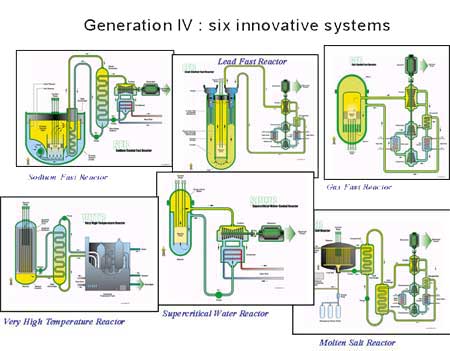
The weight of the “sustainability” criteria appears in the fact that at least 4 and possibly 5 of these systems are based on closed fuel cycle to better use the fissile natural resources, 3 of them being fast breeders.
The VHTR and (later) the GFR target not only
the generation of electric power but the co-generation of power
and hydrogen with the aim to make transportation fuels from fission
power. This is certainly necessary if we want nuclear power to
contribute very significantly to the reduction of greenhouse gases
emissions on a world scale.
Finally the future may not be limited to these 6 species. Some
intriguing concepts are developed like the AHTR, a molten salt-cooled
HTR. Some teams keep working on the Accelerator Driven subcritical
systems, the niche of which could be the transmutation of minor
actinides, if deemed useful at some point, etc.
6.2 INPRO, International Project on Innovative Nuclear reactors & Fuel Cycles.
In 2000, the IAEA initiated the INPRO Project in which fifteen (now eighteen) member states have worked to define "User Requirements" for innovative nuclear energy systems in the area of Economics, Sustainability and Environment, Safety, Waste Management, Proliferation Resistance and some cross-cutting issues. The time horizon of this exercise is 2050. They have also developed a methodology of assessment for such systems. Phase 1A of INPRO was completed in June 2003, and the methodology is being tested on a 6 “national cases”. Started entirely as an extrabudgetary initiative, INPRO is now partly funded by the Agency regular budget.
Based on similar analyses and motivations, the works of GIF and INPRO are not identical: GIF partners are mostly suppliers, and their work will steer the R&D, whereas INPRO expresses mostly the requirements of potential future users. Each group is quite aware of the other's results, and they have worked in cooperation on some issues (like proliferation resistance).
7. Fusion
For fusion, it is too early to see if the “natural history” approach is relevant. ITER, the big international facility about to be built, might not yet be the true equivalent of the December 1942 CP1 experiment which was our starting point… One can nevertheless remark that from a flourish of early configurations (Yin-Yang, stellarator, Z-pinch…) the Tokamak species dominates today fusion’s prehistory. I am referring only to Magnetic Confinement Fusion, because ICF does not seem to offer promising prospects for power generation.
8. Conclusion
From 0 TWh 50 years ago to some 2 600 today, more than the equivalent in primary energy of the oil production of Saudi Arabia or Russia, nuclear power has come a long way. This is where the “natural selection” has led us but this is not enough.
In the next 50 years, the most dramatic problem which we must address is probably the Energy/Climate Dilemma. One third of the 6 billion people with whom we share this planet Earth have not enough energy to lead a decent life, under any modern standard. Within fifty years, mankind will number 9 billion. Even under the most optimistic assumptions concerning increases in energy efficiency and “thrifty” development, primary energy demand will then reach at least the double of the present 10 billion tons of oil equivalent we consume every year.
On the other hand, it is scientifically established that, since the industrial revolution, we have managed to significantly affect the composition of our atmosphere, where the concentration in greenhouse effect gases (GHG) is today twice higher than the level the Earth has ever experienced since the dawn of Man. There is still some residual controversy about just how much of the global warming which occurred throughout the XXth century is due to this proven increase in GHG concentrations, but the best computer models run by the IPCC teams throughout the world agree: at least half of the warming was due to the increase in greenhouse effect. And what those models tell us about our XXIst century is far from reassuring. Any precautionary principle would require that we cut our GHG emission by half.
To complete the picture, 80% of the primary energy we use today comes from the fossil fuels, Oil, Coal and Gas, the combustion of which is the main source of GHG releases. This value of 80% takes into account the 10% coming from (non commercial) traditional biomass which remains the only source of energy for some 2 billion people today.
To face this tremendous challenge, there is no “magic bullet”, not even the nuclear bullet. We shall have to take all the measures we can take, and then some more…
-
We must address the demand side and not only the supply side of the equation. We must limit our energy consumption, increase our energy efficiency, and conserve energy. This applies first and foremost to our presently industrialized economies in the OECD, but the emerging giants, China, India, Brazil to name the biggest, must also find thrifty development paths, because of the sheer weight of their demography.
-
We shall have to “sequester” CO2 whenever and wherever technically feasible. The development of sequestration is still in its infancy, and the long-term safety assessment of disposal sites will not be much easier than that of radwastes, but I do not believe we can do without it.
-
We must increase in our energy mix the share of non GHG-emitting sources, namely nuclear power, hydropower and other renewables.
It is my firm belief that to tackle such a problem, all those measures will be necessary. It would be dramatically unrealistic to hope to succeed without a significant increase in the contribution of nuclear power: for electricity generation, of course, but later for other uses like water desalination, process heat, hydrogen production…
Let us hope that the formalized selection process
which the nuclear community is attempting presently will prove
efficient, and allow nuclear power to meet our hopes.
REFERENCES
[1] Alvin M. Weinberg. The First Nuclear Era /
The life and Times of a Technological Fixer. AIP Press 1994
[2] John W. Simpson. Nuclear Power from Underseas to Outer Space. ANS 1995
[3] Controlled Nuclear Chain Reaction: The First Fifty Years. ANS 1992
[4] Bertrand Goldschmidt . L'Aventure Atomique, Fayard 1962
[5] Bertrand Goldschmidt. Les Rivalités Atomiques 1939-1966 Fayard 1967
[6] Bertrand Goldschmidt. Le Complexe Atomique Fayard 1980
[7] Bertrand Goldschmidt. Pionniers de l'Atome. Stock 1987
[8] Jacques Leclercq. L'Ere Nucléaire. Hachette 1986
[9] L'Aventure de l'Atome. Flammarion 1992
[10] Repères chronologiques de l'histoire du nucléaire 1896-1995. CEA 1998
[14] ELECNUC – Les centrales nucléaires dans le monde, CEA/DES/SEE 2002
[15] Les coûts de référence de la production électrique. DGEMP France 2003 (www.industrie.gouv.fr)
[16] S. Rissanen, R. Tarjanne, University of Lapaarenta, Finland 2004
[17] INPRO, IAEA Tecdoc 1362. 2003
[18] The Roadmap to Generation IV. GIF 2003
| |


